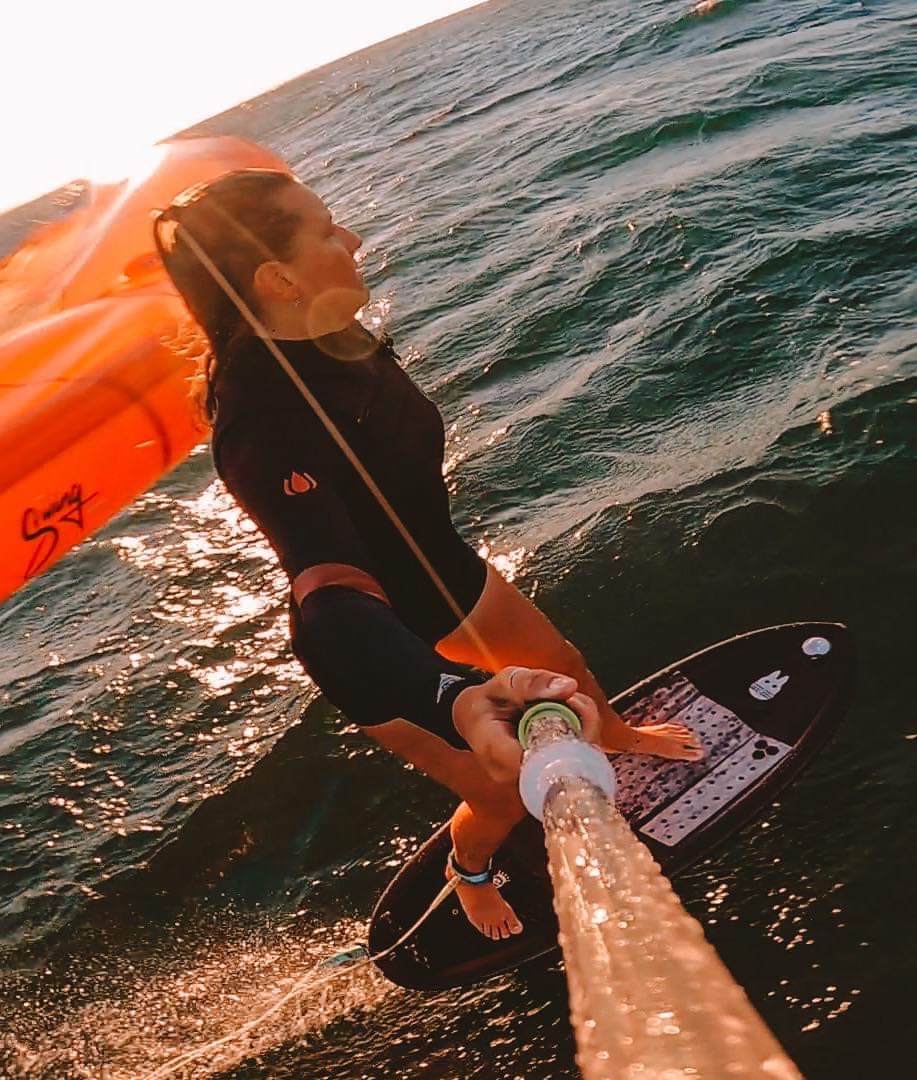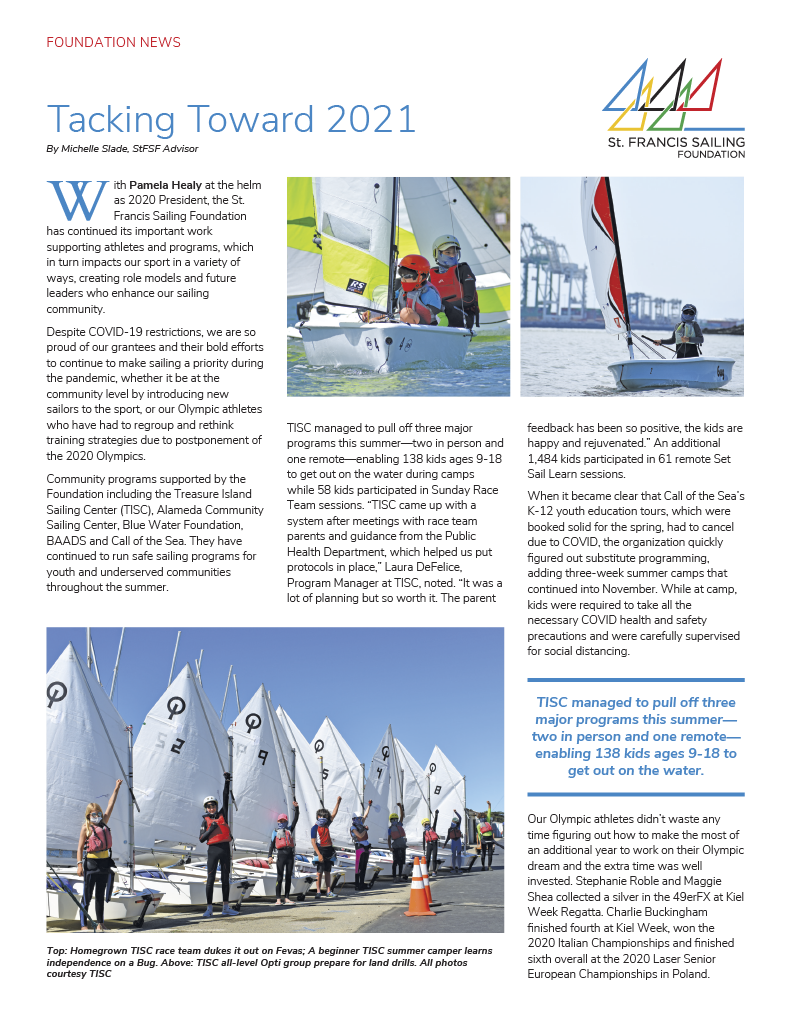The Foundation is proud to support an engaging and talented group of young sailors, including Carmen Berg, Cali Salinas, and Charlotte Versavel. All three kept their sailing in forward momentum throughout 2020, with a positive focus on better things to come this year, as they share here.
 20-year old Cali Salinas from San Francisco, Calif., is a sophomore at Tufts. She’s been sailing for 7 years:
20-year old Cali Salinas from San Francisco, Calif., is a sophomore at Tufts. She’s been sailing for 7 years:
With COVID changing all of my plans by sending me home during my freshman spring semester at Tufts and having to stay at home, I thought I wasn’t going to be able to sail much at all for the remainder of the year. I honestly thought the year was not going to be one to remember, but I was quite wrong.
In June, I crewed on the Nacra 17 with Ben Rosenberg, both of us thinking we would just sail the boat for a week just for fun, but we discovered that we sailed well together. I had already sailed Nacra 15s in high school and missed going fast. The foiling Nacra 17 redefined what fast really meant to me. Ben and I decided we wanted to sail more together and drove the boat from Rhode Island to Long Beach, CA where we sailed with the US Sailing Team.
We ended up staying in Long Beach from July to October, doing school online. Being able to stay an extra month in Long Beach allowed us to reach a baseline that let us take some time off during college for a few months and come back to sailing and feeling comfortable in the boat.
Now that I am on winter break, I can get back to foiling everyday with Ben in Florida. We are currently in Fort Lauderdale sailing with the Olympic team, Riley Gibbs and Anna Weis coached by Sally Barkow and will go to Miami in a couple weeks to sail the Miami OCR events on the Nacra 17. We are learning lots sailing in the big waves in Fort Lauderdale and are excited to get to flat water, where foiling will feel like a piece of cake.
Our goal for the summer of 2021 is to medal at the Nacra 17 Junior World Championships in Gdynia, Poland. With all the physical training through Anna Tobias Tunnicliffe’s training program, the invaluable knowledge we’ve learned from the other Nacra 17 sailors, and especially from Sally Barkow, we see this goal as achievable. As a female crew, I am inspired everyday when I can sail alongside a powerhouse team like Riley/Anna who motivate Ben and I to follow their footsteps.
One of the main reasons I love sailing this boat is how much it pushes me physically and mentally. The crew position is so physically demanding, and I hope I can inspire other girls by showing them that sailing the boat like a girl is strong, fast, and beautiful.
 17-year-old Carmen Berg is from Carmel, Calif. A junior at The Stevenson School, she’s been sailing for 8 years.
17-year-old Carmen Berg is from Carmel, Calif. A junior at The Stevenson School, she’s been sailing for 8 years.
2020 began with me and my crew Onni Kuisma (from Finland) training almost every weekend on the Nacra 15, preparing for upcoming events in the spring and summer. With the CISA Clinic and Mid Winters West Championship scheduled for Long Beach, Adam Corpuz-Lahne trailered our boats down to ABYC, so we could practice and acclimate with the conditions.
As COVID arose, the events we were training for were canceled, and our boats were brought back to Richmond. Having no events scheduled for the near future, Onni and I decided to keep training and use the time we were given to focus on specific skills and techniques. We continued this until early summer when I received the news that Onni was moving back to Finland. We wrapped up our final weeks together, enjoying sailing in the summer breeze and our time out on the water.
After Onni’s departure, I decided to crew on an i420 and was given the opportunity to train in Southern California for two months. The program encompassed daily strength training, lessons on weather, sail making, fiberglass repair, and charting. As expected, summer conditions allowed for light wind practice, learning patience, and the importance of paying attention to details. Breeze training was in Long Beach, and while there, I was given the opportunity to skipper a Nacra17 with Anna Weis for a practice race against the other 17s. It was an amazing experience to sail with her and get a glance into Riley and Anna’s training leading up to the 2021 Olympic Games in Tokyo. I concluded the summer with great memories, and I acquired new skills as I returned home for the school year.
I continued to sail i420s in the fall and sail my Nacra 15 as opportunities allowed, and it was great to get back in the boat after some time being away. As COVID continued to cause widespread cancellation of sailing events throughout the world, I am focusing on regattas scheduled for the spring. Our goal is to qualify for i420 World Championship in San Remo, Italy, being held in July 2021.
Despite the craziness of this past year, I have been able to use the absence of competition to grow and take time to develop as a young athlete and learn many new things about the sport I love. Upon reflection, I am incredibly grateful for my coaches and the lessons they have taught me. I always enjoy being out on the water and am excited to continue to learn and hopefully compete in the coming months.
 18 year old Charlotte Versavel, from Palo Alto, Calif., is a senior at Palo Alto High. She’s been sailing 8 years.
18 year old Charlotte Versavel, from Palo Alto, Calif., is a senior at Palo Alto High. She’s been sailing 8 years.
At the beginning of the year, Jack Sutter and I planned to compete in the US Youth Worlds Qualifiers, the first of which was early April in Long Beach. We were also hoping to get more experience sailing internationally: spending summer 2020 traveling and competing in Europe in the lead up to the 2020 Youth Worlds, which were to be held in December 2020 in Brazil.
When coronavirus put the world on hold, I wanted to use the extra time and flexibility of online school to sail more while Jack’s motivation to train was reduced as we saw our summer events being canceled. It was frustrating for both of us and one relief was the practices in the Nacra 15 that Adam Corpuz-Lahne organized and coached. Adam let me sit on the coach boat (with my buff covering my face) and sometimes switched me in with the other Nacra teams. The practices were experimental and exciting, resulting in some promising light wind speed techniques and as well as heavy wind confidence.
I was itching to get back to sailing, so after trying out a friend’s Waszp, I convinced my mom to invest in an early Christmas-and-Birthday present. My hope was that a single-handed boat would let me sail as often as I wanted and would help me make the transition with Jack into the foiling Nacra 17.
I spent the rest of the summer in a variety of new hobbies. I became a certified US Sailing Level 1 Instructor and hiked a bunch in Tahoe (summiting Round Top, Dick’s Peak, and Mt. Tallac). When my Waszp arrived in the late days of summer, I spent a couple days in the backyard, splicing, and figuring out how the systems worked. My maiden voyage was out of Saint Francis, alongside Luke Froeb and Declan Donovan, and coached by Adam.
When school started again, in a revised online format, I put my head down and started applying to colleges. This gave me less time for sailing, but Jack and I got a couple of days on the water in organized N15 practices (out of Richmond Yacht Club) coached by Adam. On weekends that Jack wasn’t available to sail, I started training (out of Richmond YC) in the Waszp with Molly Carapiet who got her Waszp at around the same time, and Helena Scutt, who does loops around us in her Moth. I feel fortunate to have the opportunity to sail with two women who are kind, knowledgeable sailors, and humble even with their success and accomplishments.
Due to the busy-ness of our schedules, and differences in our goals, Jack and I decided to stop sailing together in late 2020. While I still have a year left in the Youth Sailing Circuit, I’ve been enjoying the challenge of learning a new boat (the Waszp), and feel much safer (less likely to get or spread the virus) in a singlehanded boat where I don’t need to travel to find people to sail against. While I didn’t consider myself someone who would thrive in solo sailing, fixing my own problems and being self-sufficient has given me confidence and contributed to mental growth.
I finished submitting college applications just a couple of days ago and will have more time to get on the water in the spring. I’m hoping for flat water and consistent wind that will let me foil as often as possible. Once I get more comfortable in the Waszp, I’ll try rally the other Bay Area boats to put together some local events, but for now, I have lots to learn.
After a whirlwind 2020, I don’t want to make any assumptions for what sailing will look like this summer, but I’ll find a way to get on the water and enjoy myself, before I head off to college where I plan to sail and compete!
Main image – Cali Salinas & Ben Rosenberg Nacra 15 training.
###


















